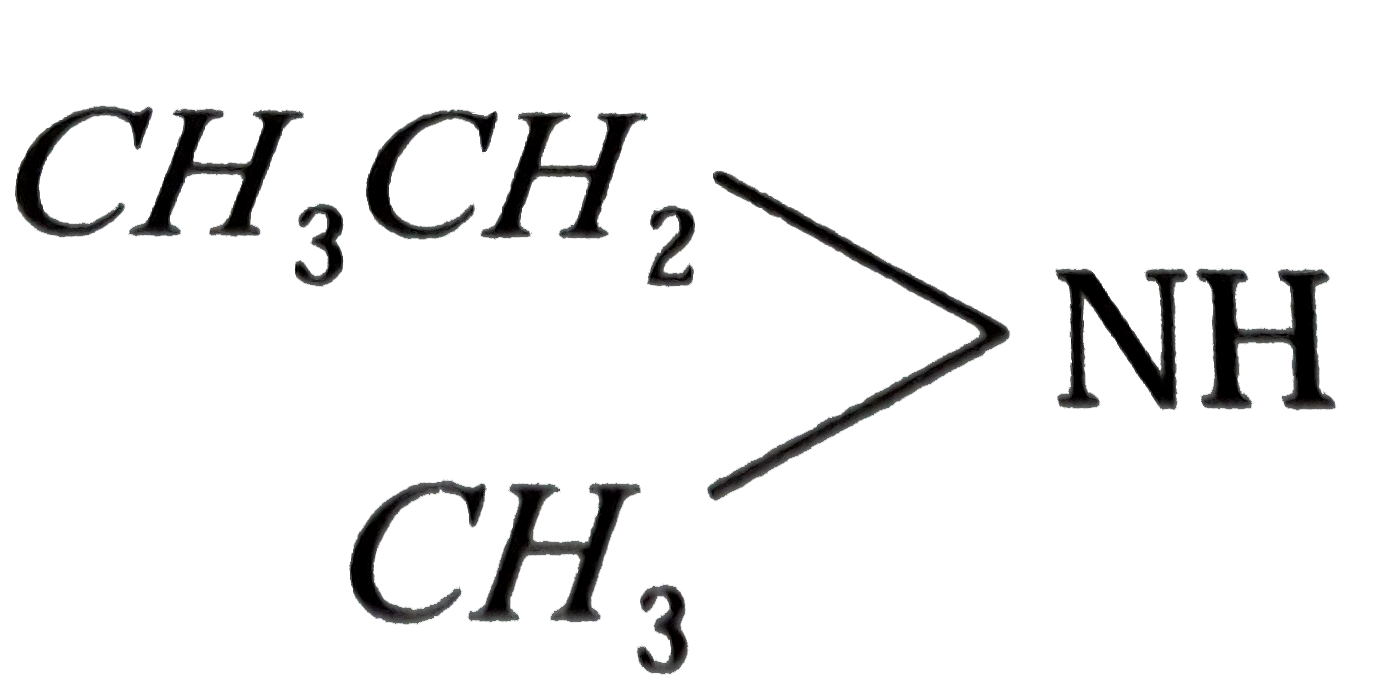Which of the following would be among the products of the reactions between ammonia reacts with bromoethane?
(i) CH3CH2NH2
(ii) (CH3CH2)2NH
(iii) (CH3CH2)3N
(iv) (CH3CH2)4N+Br−
only i
only i and ii
only i, ii, and iii
all- i, ii, iii and iv
To determine the products formed when ammonia reacts with bromoethane, we can analyze the reaction step by step.
Step 1: Understanding the Reactants
- Ammonia (NH₃) is a nucleophile, meaning it can donate a pair of electrons to form a bond.
- Bromoethane (C₂H₅Br) is an alkyl halide that can react with nucleophiles.
Step 2: First Reaction - Formation of Primary Amine
When ammonia reacts with bromoethane, the first step involves the nucleophilic substitution where ammonia attacks the carbon atom bonded to the bromine atom:
- Reaction:
\(
\text{NH}_3 + \text{C}_2\text{H}_5\text{Br} \rightarrow \text{C}_2\text{H}_5\text{NH}_2 + \text{HBr}
\)
- Product: Ethylamine (C₂H₅NH₂), which corresponds to option (i) CH₃CH₂NH₂.
Step 3: Second Reaction - Formation of Secondary Amine
The ethylamine can further react with another molecule of bromoethane:
- Reaction:
\(
\text{C}_2\text{H}_5\text{NH}_2 + \text{C}_2\text{H}_5\text{Br} \rightarrow \text{C}_2\text{H}_5\text{NH}\text{C}_2\text{H}_5 + \text{HBr}
\)
- Product: Diethylamine (C₂H₅)₂NH, which corresponds to option (ii) (CH₃CH₂)₂NH.
Step 4: Third Reaction - Formation of Tertiary Amine
Next, the diethylamine can react with another molecule of bromoethane:
- Reaction:
\(
\text{(C}_2\text{H}_5\text{)}_2\text{NH} + \text{C}_2\text{H}_5\text{Br} \rightarrow \text{(C}_2\text{H}_5\text{)}_3\text{N} + \text{HBr}
\)
- Product: Triethylamine (C₂H₅)₃N, which corresponds to option (iii) (CH₃CH₂)₃N.
Step 5: Fourth Reaction - Formation of Quaternary Ammonium Salt
Finally, triethylamine can react with another bromoethane to form a quaternary ammonium salt:
- Reaction:
\(
\text{(C}_2\text{H}_5\text{)}_3\text{N} + \text{C}_2\text{H}_5\text{Br} \rightarrow \text{(C}_2\text{H}_5\text{)}_4\text{N}^+ + \text{Br}^-
\)
- Product: Tetraethylammonium bromide (C₂H₅)₄N⁺Br⁻, which corresponds to option (iv) (CH₃CH₂)₄N⁺Br⁻.
Conclusion
From the above steps, we can conclude that all four products can be formed during the reaction sequence:
- (i) Ethylamine (C₂H₅NH₂)
- (ii) Diethylamine ((C₂H₅)₂NH)
- (iii) Triethylamine ((C₂H₅)₃N)
- (iv) Tetraethylammonium bromide ((C₂H₅)₄N⁺Br⁻)
Thus, the correct answer is all 1, 2, 3, and 4.
- Ammonia (NH₃) is a nucleophile, meaning it can donate a pair of electrons to form a bond.
- Bromoethane (C₂H₅Br) is an alkyl halide that can react with nucleophiles.
When ammonia reacts with bromoethane, the first step involves the nucleophilic substitution where ammonia attacks the carbon atom bonded to the bromine atom:
- Reaction:
\(
\text{NH}_3 + \text{C}_2\text{H}_5\text{Br} \rightarrow \text{C}_2\text{H}_5\text{NH}_2 + \text{HBr}
\)
- Product: Ethylamine (C₂H₅NH₂), which corresponds to option (i) CH₃CH₂NH₂.
The ethylamine can further react with another molecule of bromoethane:
- Reaction:
\(
\text{C}_2\text{H}_5\text{NH}_2 + \text{C}_2\text{H}_5\text{Br} \rightarrow \text{C}_2\text{H}_5\text{NH}\text{C}_2\text{H}_5 + \text{HBr}
\)
- Product: Diethylamine (C₂H₅)₂NH, which corresponds to option (ii) (CH₃CH₂)₂NH.
Next, the diethylamine can react with another molecule of bromoethane:
- Reaction:
\(
\text{(C}_2\text{H}_5\text{)}_2\text{NH} + \text{C}_2\text{H}_5\text{Br} \rightarrow \text{(C}_2\text{H}_5\text{)}_3\text{N} + \text{HBr}
\)
- Product: Triethylamine (C₂H₅)₃N, which corresponds to option (iii) (CH₃CH₂)₃N.
Finally, triethylamine can react with another bromoethane to form a quaternary ammonium salt:
- Reaction:
\(
\text{(C}_2\text{H}_5\text{)}_3\text{N} + \text{C}_2\text{H}_5\text{Br} \rightarrow \text{(C}_2\text{H}_5\text{)}_4\text{N}^+ + \text{Br}^-
\)
- Product: Tetraethylammonium bromide (C₂H₅)₄N⁺Br⁻, which corresponds to option (iv) (CH₃CH₂)₄N⁺Br⁻.
From the above steps, we can conclude that all four products can be formed during the reaction sequence:
- (i) Ethylamine (C₂H₅NH₂)
- (ii) Diethylamine ((C₂H₅)₂NH)
- (iii) Triethylamine ((C₂H₅)₃N)
- (iv) Tetraethylammonium bromide ((C₂H₅)₄N⁺Br⁻)
Topper's Solved these Questions
Similar Questions
Name the functional groups present in the following compounds:
(i) CH3−CH2−CH2−OH
(ii) CH3−CH2−CH2−COOH
(iii) CH3−CH2−CHO
(iv) CH3−CO−CH2−CH3
View SolutionWhich alkyl halide from the following pairs would you expect to react more rapidly by an SN2 mechanism ? Explain your answer.
(i) CH3CH2CH2CH2Br or CH3CH2(Br)CH3
(ii) CH3CH2CH(Br)CH3 or (CH3)3CBr
(iii) (CH3)2CHCH2CH2Br or CH3CH2CH(CH3)CH2Br
View Solution
Knowledge Check
Which of the following is a gas at room temperature ?
CH3NH2 (ii) CH3CH2NH2 (iii) (CH3)2 (iv) (CH3)3NA(i)B(i),(ii)C(i),(ii),(iii)D(i),(ii),(iii),(iv)Arrange the following molecules has highest dipole moment ?
(i) CH3Br (ii) CH3CH2Br
(iii) CH3CH2CH2Br
(iv) CH3CH2CH2CH2BrA(i)>(ii)>(iii)>(iv)B(iv)>(iii)>(ii)>(i)C(i)>(iii)>(ii)>(iv)D(iii)>(iv)>(i)>(ii)Which of the following should be most volatile?
I) CH3CH2CH2NH2II)(CH3)3NIII)

IV) CH3CH2CH3AIIBIVCIDIII
Which of the following compounds gives fastest reaction with HBr and why?
(i) (CH3)3_OH (ii) CH3CH2CH2OH
(iii) CH3OH∣CHCH3 (iv) CH3CH3∣CHCH2OH
View SolutionArrange the following compounds in order of their reactivity towards SN2 reaction
(i) CH3(CH2)3CH2Br
(ii) (CH3)2CHCH2CH2Br
(iii) CH3CH2−CH3| CH−CH2Br
(iv) CH3CH2−CH3| CH−CH2Br
View SolutionWhich is the most suitable reagent among the following to distinguish compound (iii) from the rest of the compounds
i. CH3−C≡C−CH3
ii. CH3−CH2−CH2−CH3
iii. CH3−CH2−C≡CH
iv. CH3−CH=CH2
View SolutionArrange the following compounds in order of their reactivity towards SN2 reaction.
(i) CH3(CH2)3CH2Br
(ii) (CH3)2CHCH2CH2Br
(iii) CH3CH2−CH3∣CH−CH2Br
(iv) CH3−CH3∣C∣CH3−CH2Br
View SolutionArrange the following compounds in order of their reactivity towards SN2 reaction
(i)CH3(CH2)2CH2Cl
(ii) (CH3)2CHCH2CH2Cl
(iii) CH3CH2−CH3CH3∣CH−CH2Cl
(iv) CH3−CH3∣C∣CH3−CH2Cl
View Solution